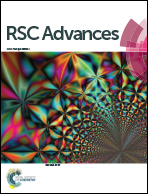Self-assembly and recognition properties of a tetraanionic macrocyclic boronate ester in aqueous medium†
Abstract
A tetraanionic [2 + 2] boronate ester macrocycle is self-assembled from a dicatechol 3,3,3′,3′-tetramethyl-1,1′-spirobiindane-5,5′,6,6′-tetraol and 1,4-benzenediboronic acid in the presence of 2 equivalents of NaOH in water containing 0–5% vol DMSO. No templating by potential guest molecules is required for the self-assembly with close to quantitative yield of the macrocycle. The macrocycle is stable and binds efficiently various cationic guests at pH 9. For alkali and R4N+ cations the association constants KA are growing in the order Cs+ < Me ≪ Et ≪ n-Pr with KA = 180 M−1 for Cs+ and >105 M−1 for Pr4N+ The inclusion of R4N+ cations is confirmed by 1D and 2D 1H NMR and is further characterized by quantum mechanical calculations. The macrocycle binds efficiently some biologically important cationic guests (choline, acetylcholine, 1-methylnicotinamide) and discriminates Arg-OMe over Lys-OMe. It forms a highly fluorescent complex with an isoquinoline alkaloid berberine, which can be used for optical sensing of tetraalkylammonium guests by a displacement or ternary complex formation mechanism. These results extend previously limited to solid state or non-aqueous media applications of self-assembled boronate ester hosts for molecular recognition to practically more important aqueous solutions.


 Please wait while we load your content...
Please wait while we load your content...